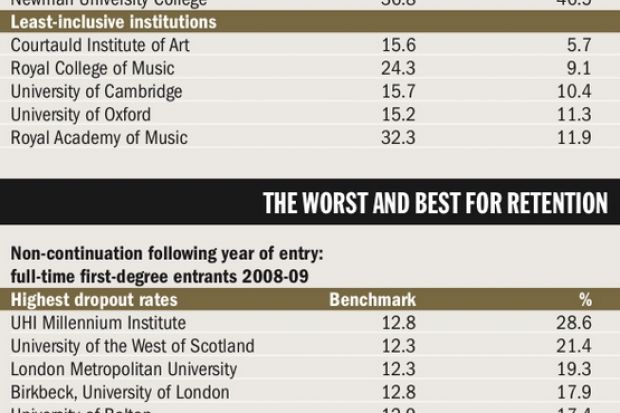Universities are continuing to make steady progress on widening access and improving dropout rates, according to official figures.
Across the UK, the proportion of young full-time undergraduate entrants from state schools has again risen slightly, from 89 per cent in 2008-09 to 89.4 per cent in 2009-10.
The data published by the Higher Education Statistics Agency form part of the annual performance indicators for the sector. They also show that, as last year, dropout rates have fallen.
Among students starting full-time first degrees in the UK in 2008-09, the proportion who had dropped out a year later was 7.9 per cent, down from 8.6 per cent in 2007-08.
The most inclusive institutions were the University of Greenwich and the University of Bradford (see table right), where more than half of young full-time undergraduate entrants were from lower socio-economic groups.
In contrast, students from under-represented groups accounted for 10 per cent or less at the Courtauld Institute of Art, the Royal College of Music and the University of Cambridge.
The same three institutions also had some of the lowest dropout rates.
The highest early dropout rates were found at the former UHI Millennium Institute, now the University of the Highlands and Islands (28.6 per cent), the University of the West of Scotland (21.4 per cent) and London Metropolitan University (19.3 per cent).
London Met is also the UK's seventh most socially diverse, according to the Hesa figures.
Among the highly selective research-intensive Russell Group universities, the overall proportion of young full-time undergraduates from state secondary schools did not increase between 2008-09 and 2009-10.
Wendy Piatt, director general of the Russell Group, said the figures illustrated "the particular challenges" that the country's most selective universities face in widening participation.
She pointed to figures showing that the proportion of A-level students achieving three As or more at independent schools had risen from 15.1 per cent to 32.3 per cent over the past 15 years.
Dr Piatt also claimed that Hesa's benchmarks for widening participation were "unsuitable, insufficient and flawed" targets.
Welcoming the publication of the sector-wide figures, Nicola Dandridge, chief executive of Universities UK, said the country had one of the world's highest completion rates for higher education.
However, she sounded a note of caution ahead of changes to the tuition fee system in England in 2012. "With considerable changes to the funding and fees system on the horizon, it will be vitally important to monitor the impact on students from disadvantaged backgrounds," Ms Dandridge said.
"UUK plans to carry out detailed analysis of this as the changes are introduced. We must ensure that the public understands fully the proposed changes to higher education funding."
rebecca.attwood@tsleducation.com.
Register to continue
Why register?
- Registration is free and only takes a moment
- Once registered, you can read 3 articles a month
- Sign up for our newsletter
Subscribe
Or subscribe for unlimited access to:
- Unlimited access to news, views, insights & reviews
- Digital editions
- Digital access to THE’s university and college rankings analysis
Already registered or a current subscriber? Login
